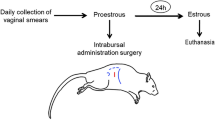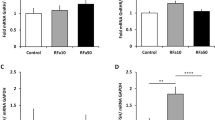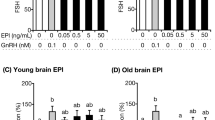Abstract
THE catechol oestrogens, including 2-hydroxyoestradiol and 2-hydroxyoestrone, are recognised as major metabolic products of oestrogen1. Catechol oestrogens are present in both pituitary and hypothalamus in concentrations at least tenfold higher than the parent oestrogens2. In addition, the synthesis of catechol oestrogens by rat hypothalamic tissue in vitro has also been reported2,3. Catechol oestrogens compete with 17-β-oestradiol (E2) for soluble oestrogen receptors of the pituitary and hypothalamus4, suggesting a role for these compounds in the control of gonadotrophin secretion within the pituitary–hypothalamic axis. We have investigated the effects of 2-hydroxyoestradiol on the oestrogen-elicited accumulation of cyclic AMP in intact hypothalami in vitro, and we report here that 2-hydroxyoestradiol antagonises the increase in cyclic AMP elicited in hypothalami of immature female rats by both diethylstilboestrol (DBS) and E2, suggesting that 2-hydroxyoestradiol may function as an endogenous anti-oestrogen.
This is a preview of subscription content, access via your institution
Access options
Subscribe to this journal
Receive 51 print issues and online access
$199.00 per year
only $3.90 per issue
Buy this article
- Purchase on Springer Link
- Instant access to full article PDF
Prices may be subject to local taxes which are calculated during checkout
Similar content being viewed by others
References
Kraychy, S. & Gallagher, T. F. J. biol. Chem. 229, 519–526 (1957).
Paul, S. & Axelrod, J. Science (in the press).
Fishman, J. & Norton, B. Endocrinology 96, 1054–1059 (1975).
Fishman, J. & Norton, B. in Advances in the Biosciences: Schering Workshop on Central Actions of Estrogenic Compounds (ed. Raspe, G.) 123–131 (Pergamon, Oxford, 1975).
Davies, I. J., Naftolin, R., Ryan, K. J., Fishman, J. & Siu, J. Endocrinology 97, 554–557 (1975).
Weissman, B. A. & Skolnick, P. Neuroendocrinology 18, 27–34 (1975).
Weissman, B. A., Daly, J. W. & Skolnick, P. Endocrinology 97, 1559–1566 (1975).
Elliott, K. A. C. Meth. Enzym. 1, 3–9 (1955).
Gilman, A. G. Proc. natn. Acad. Sci. U.S.A. 67, 305–312 (1970).
Schultz, J. & Daly, J. W. J. biol. Chem. 248, 843–852 (1973).
Miller, G. L. Analyt. Chem. 31, 964 (1959).
Lowry, O. H., Rosebrough, N. J., Farr, A. L. & Randall, R. J. J. biol. Chem. 193, 265–275 (1951).
Gunaga, K. P. & Menon, K. M. J. Biochem. biophys. Res. Commun. 54, 440–448 (1973).
Gunaga, K. P., Kawano, A. & Menon, K. M. J. Neuroendocrinology 16, 273–281 (1974).
Breuer, H. & Köster, G. J. Steroid Biochem. 5, 961–967 (1974).
Engel, L. L., Bagget, B. & Carter, P. Endocrinology 61, 113–114 (1957).
Gethmann, U. & Knuppen, R. Hoppe Seyler's Z. physiol. Chem. 357, 1011–1013 (1976).
Naftolin, F. et al. Biochem. biophys. Res. Commun. 64, 905–910 (1975).
Author information
Authors and Affiliations
Rights and permissions
About this article
Cite this article
PAUL, S., SKOLNICK, P. Catechol oestrogens inhibit oestrogen elicited accumulation of hypothalamic cyclic AMP suggesting role as endogenous anti-oestrogens. Nature 266, 559–561 (1977). https://doi.org/10.1038/266559a0
Received:
Accepted:
Issue Date:
DOI: https://doi.org/10.1038/266559a0
This article is cited by
-
3,4-Bis(3′-hydroxyphenyl)hexane — A new mammary tumor-inhibiting compound
Journal of Cancer Research and Clinical Oncology (1982)
Comments
By submitting a comment you agree to abide by our Terms and Community Guidelines. If you find something abusive or that does not comply with our terms or guidelines please flag it as inappropriate.



